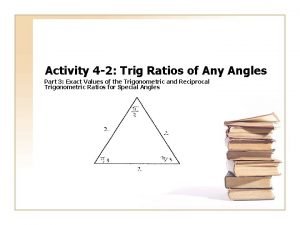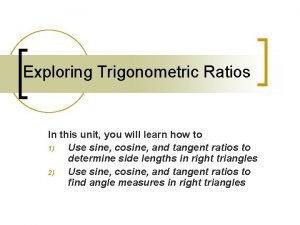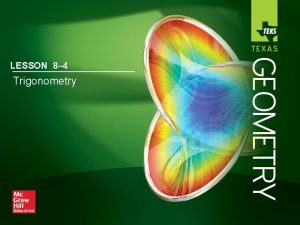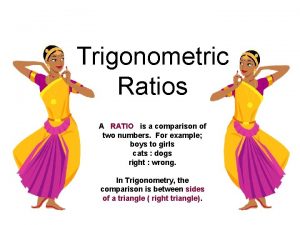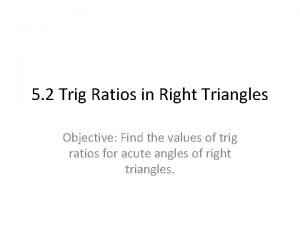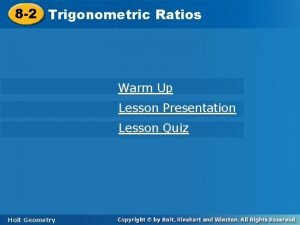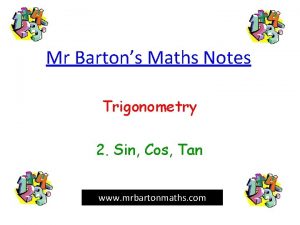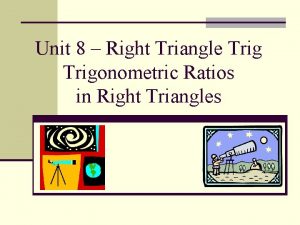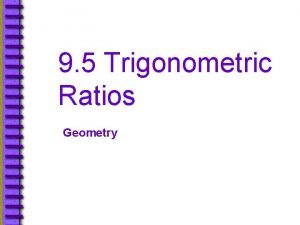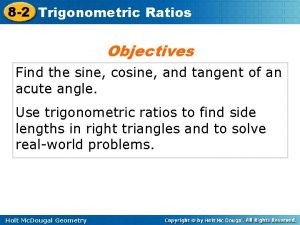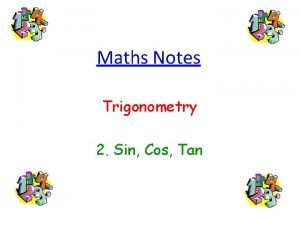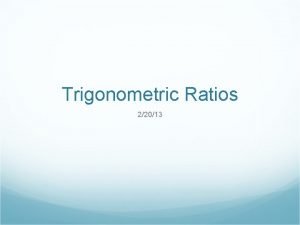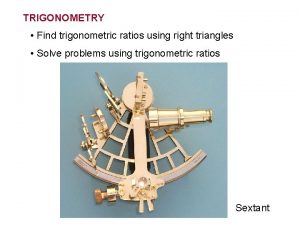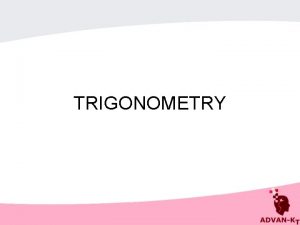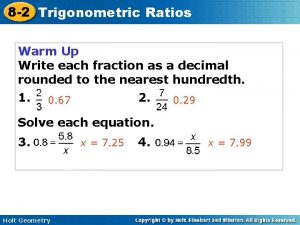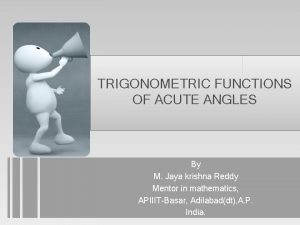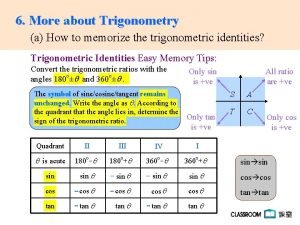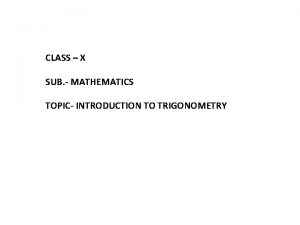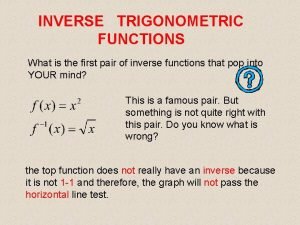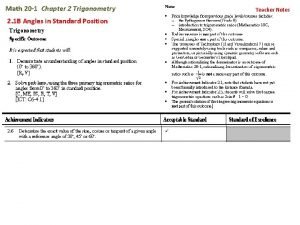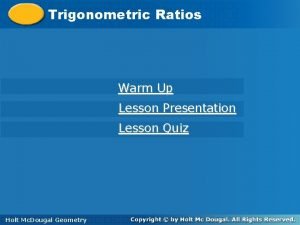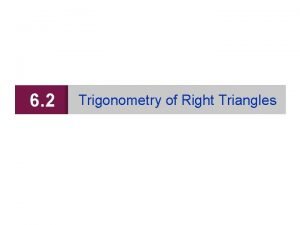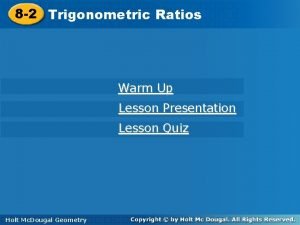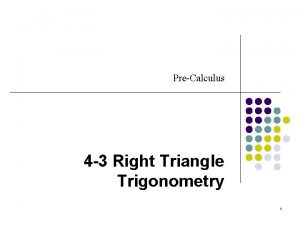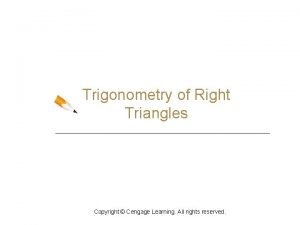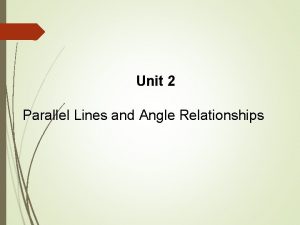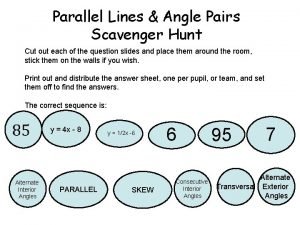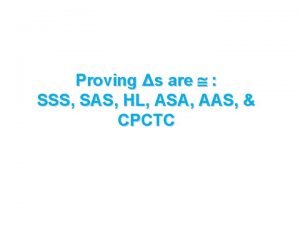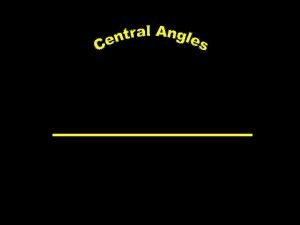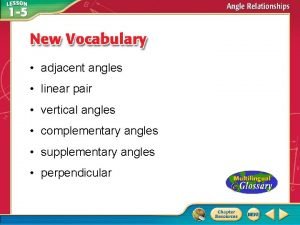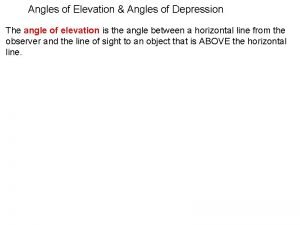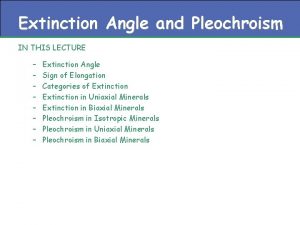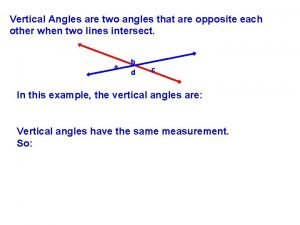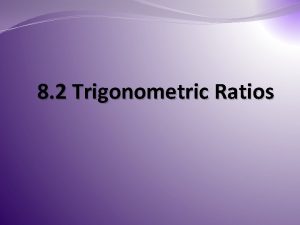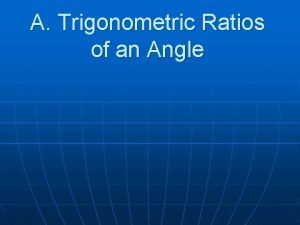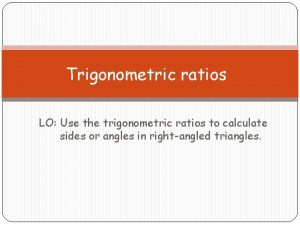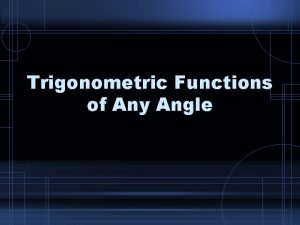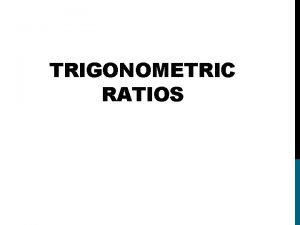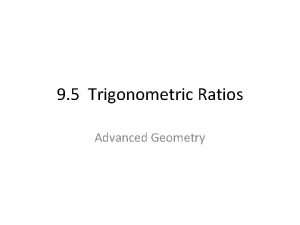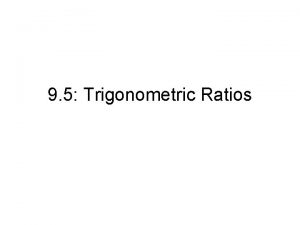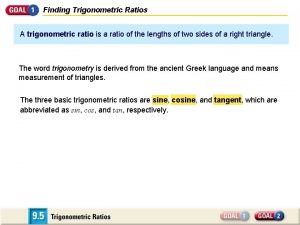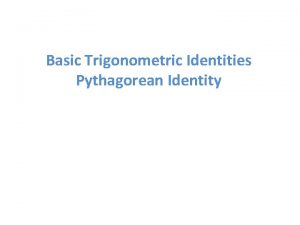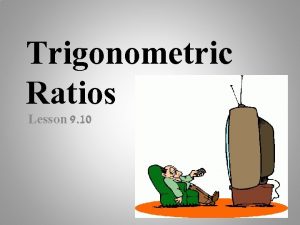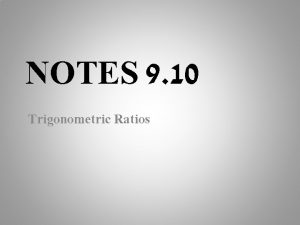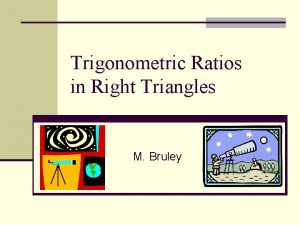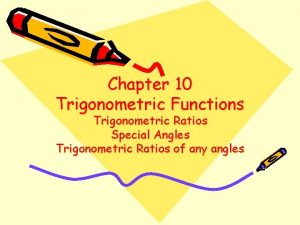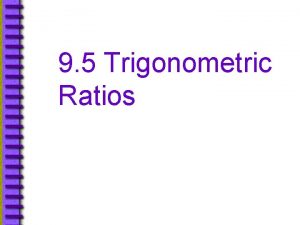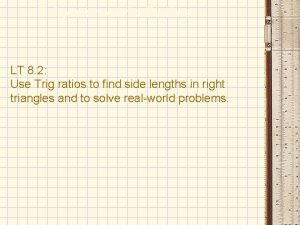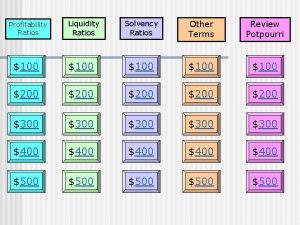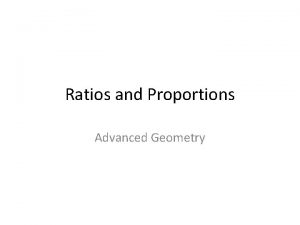Trigonometric Ratios of Any Angle P A Hunt

























































- Slides: 57

Trigonometric Ratios of Any Angle © P. A. Hunt http: //teachfurthermaths. weebly. com

Lesson Objectives: 1. To understand what is meant by: circular functions; quadrants; positive angles; negative angles. 2. To recall the main characteristics of the graphs of y = sin x, y = cos x and y = tan x. 3. To consider the main trigonometric ratios in all 4 quadrants. 4. To introduce and use the CAST diagram for solving simple trig. ratio problems. 5. To solve simple trig. ratio problems graphically. 6. To solve simple trig. ratio problems by identifying a quicker method. © P. A. Hunt

Did you know…? 1 …that a positive angle is measured in an anticlockwise direction from the positive x-axis? 60◦

Did you know…? 2 … that a negative angle is measured in a clockwise direction from the positive x-axis? -60◦

Did you know…? 3 … that there are 4 quadrants, named as shown below: 2 nd quadrant 1 st quadrant 3 rd quadrant 4 th quadrant

Did you know…? 4 … that the trigonometric ratios sin x, cos are called circular functions. x and tan x

Can you sketch the graph of y = sin x ? Main Characteristics 1 The graph has a period of 360◦. 2 Sin x has a minimum value of -1 and a maximum value of 1.

Can you sketch the graph of y = cos x ? Main Characteristics 1 The graph has a period of 360◦. 2 Cos x has a minimum value of -1 and a maximum value of 1. 3 The graph is a translation of the sine graph by 90◦ to the left.

Can you sketch the graph of y = tan x ? Main Characteristics 1 The graph has a period of 180◦. 2 Tan x has no maximum value and no minimum value. 3 Tan x is undefined at -270◦, -90◦, 270◦ etc.

Circular Functions P(x, y) Consider a unit circle of centre O. 1 Note: Any radius will suffice but, for the sake of simplicity, we will use the unit circle. Consider also the line OP (shown) where P is a point on the circle in the 1 st quadrant. We will choose the angle between OP and the positive x-axis to be θ. O

Circular Functions – the 1 st Quadrant P(x, y) Now consider the triangle OPQ. We will now recall the trigonometric ratios with which we are already familiar: 1 O Q

Circular Functions – the 1 st Quadrant P(x, y) Now consider the triangle OPQ. We will now recall the trigonometric ratios with which we are already familiar: 1 O Q

Circular Functions – the 1 st Quadrant P(x, y) Now consider the triangle OPQ. We will now recall the trigonometric ratios with which we are already familiar: 1 O Q

Circular Functions – the 1 st Quadrant P(x, y) 1 Note : In the 1 st Quadrant, (i. e. for an acute angle) O Q

Circular Functions – the 1 st Quadrant P(x, y) 1 We will now extend these definitions to angles that lie outside of the 1 st quadrant. O Q

Circular Functions – the 2 nd Quadrant P(x, y) 1 This time our angle lies in the 2 nd Quadrant. Let Φ (phi) be the acute angle between our line and the x-axis. O

Circular Functions – the 2 nd Quadrant P(x, y) 1 Using our definitions above: Q because x is negative O So just use the ‘associated acute’ angle Φ, and note the sign.

Circular Functions – the 2 nd Quadrant P(x, y) 1 Note : In the 2 nd Quadrant, Q O So just use the ‘associated acute’ angle Φ, and note the sign.

Circular Functions – the 3 rd Quadrant This time our angle lies in the 3 rd Quadrant. O 1 P(x, y)

Circular Functions – the 3 rd Quadrant Using our definitions above: Q O because y is negative 1 because x is negative because x and y are both negative P(x, y)

Circular Functions – the 3 rd Quadrant Note : In the 3 rd Quadrant, Q O 1 P(x, y)

Circular Functions – the 4 th Quadrant This time our angle lies in the 4 th Quadrant. O 1 P(x, y)

Circular Functions – the 4 th Quadrant Using our definitions above: Q O because y is negative 1 because y is negative P(x, y)

Circular Functions – the 4 th Quadrant Note : In the 4 th Quadrant, Q O 1 P(x, y)

The CAST Diagram 2 nd Quadrant 1 st Quadrant 90 < θ < 180 0 < θ < 90 Sin > 0 All > 0 Tan > 0 Cos > 0 3 rd Quadrant 4 th Quadrant 180 < θ < 270 < θ < 360

The CAST Diagram 2 nd Quadrant 1 st Quadrant 90 < θ < 180 0 < θ < 90 S A T C 3 rd Quadrant 4 th Quadrant 180 < θ < 270 < θ < 360

Example 1 Find all the values of θ, where 0 ≤ θ ≤ 360, for which sin θ◦ = sin 50◦ S θ = 50◦ is clearly a solution A 50◦ 50◦ lies in the 1 st quadrant. T (where sin > 0) sin > 0 in the 2 nd quadrant also (draw at same angle to x-axis) Read solutions from positive x-axis C

Example 1 Find all the values of θ, where 0 ≤ θ ≤ 360, for which sin θ◦ = sin 50 ◦ S 50◦ θ = 50◦ T A 130◦ 50◦ θ = 130◦ We can see that further solutions are θ = 410◦, θ = 490◦, θ = 770◦, θ = 850◦ etc, by adding (or subtracting) multiples of 360◦ but these are outside of the required interval for this question. C

Graphical Method Find all the values of θ, where 0 ≤ θ ≤ 360, for which sin θ◦ = sin 50 ◦ y = sin θ θ θ = 50◦ θ = 130◦ Use the symmetry of the graph to read the required values

Graphical Method Find all the values of θ, where 0 ≤ θ ≤ 360, for which sin θ◦ = sin 50 ◦ y = sin θ Note that: All other solutions can be found by θ θ = 50◦ θ = 130◦

A Quicker Approach Find all the values of θ, where 0 ≤ θ ≤ 360, for which sin θ◦ = sin 50 ◦ Note that: All other solutions can be found by No other solutions in required range. The required solutions are θ = 50◦, θ = 130◦

Example 2 Find all the values of θ, where -360 ≤ θ ≤ 360, for which cos θ◦ S 60◦ T = cos 120 ◦ 120◦ θ = 120◦ is clearly a solution A 120◦ lies in the 2 nd quadrant. (where cos < 0) C cos < 0 in the 3 rd quadrant also (draw at same angle to x-axis) Read solutions from positive x-axis

Example 2 Find all the values of θ, where -360 ≤ θ ≤ 360, for which cos θ◦ = cos 120 ◦ S 60◦ T 240◦ A 120◦ θ = 240◦ Cθ = -120 Subtracting 360◦ from each solution, θ = -240◦ ◦ The required solutions are θ = -240◦, θ = -120◦, θ = 240◦

Graphical Method Find all the values of θ, where -360 ≤ θ ≤ 360, for which cos θ◦ = cos 120 ◦ y = cos θ θ = -240◦ θ = -120◦ θ = 240◦ θ = 120◦ θ

Graphical Method Find all the values of θ, where -360 ≤ θ ≤ 360, for which cos θ◦ = cos 120 ◦ y = cos θ Note that: θ = -240◦ All other solutions can be found by θ = -120◦ θ = 240◦ θ = 120◦ θ

A Quicker Approach Find all the values of θ, where -360 ≤ θ ≤ 360, for which cos θ◦ = cos 120 ◦ Note that: All other solutions can be found by The required solutions are θ = -240◦, θ = -120◦, θ = 240◦

Example 3 Find all the values of θ, where -360 ≤ θ ≤ 360, for which tan θ◦ = tan 240 ◦ S A 240◦ 60◦ T θ = 60◦ θ = 240◦ Cθ = -120 Subtracting 360◦ from each solution, θ = -300◦ ◦ The required solutions are θ = -300◦, θ = -120◦, θ = 60◦, θ = 240◦

Example 3 Find all the values of θ, where -360 ≤ θ ≤ 360, for which tan θ◦ = tan 240 ◦ θ θ = -300◦ θ = -120◦ θ = 60◦ θ = 240◦

Example 3 Find all the values of θ, where -360 ≤ θ ≤ 360, for which tan θ◦ = tan 240 ◦ Note that: All other solutions can be found by θ = -300◦ θ θ = -120◦ θ = 60◦ θ = 240◦

A Quicker Approach Find all the values of θ, where -360 ≤ θ ≤ 360, for which tan θ◦ = tan 240 ◦ Note that: All other solutions can be found by The required solutions are θ = -300◦, θ = -120◦, θ = 60◦, θ = 240◦

Exercise For each of the following, find all values of θ in the given range. All methods Quick Method All methods Quick Method

For each of the following, find all values of θ in the given range. 100◦ S 80◦ T A 80◦ θ = 80◦ C θ = 100◦ Back to questions

For each of the following, find all values of θ in the given range. θ θ = 80◦ θ = 100◦ Back to questions

A Quicker Approach (a) Back to questions Find all the values of θ, where 0 ≤ θ ≤ 360, for which sin θ◦ = sin 80 ◦ Note that: All other solutions can be found by No other solutions in required range. The required solutions are θ = 80◦, θ = 100◦

For each of the following, find all values of θ in the given range. 230◦ S 50◦ A 130◦ 50◦ T θ = 130◦ θ = 230◦ C Back to questions

For each of the following, find all values of θ in the given range. θ = 230◦ θ = 130◦ Back to questions θ

A Quicker Approach (b) Find all the values of θ, where 0 ≤ θ ≤ 360, for which cos θ◦ = cos 130 ◦ Note that: All other solutions can be found by The required solutions are θ = 130◦, θ = 230◦ Back to questions

For each of the following, find all values of θ in the given range. S 60◦ θ = 120◦ A 300◦ θ = 300◦ Tθ = -60 Subtracting 360◦ from the 2 nd solution, ◦ The required solutions are θ = -60◦, θ = 120◦, θ = 300◦ 120◦ 60◦ C Back to questions

For each of the following, find all values of θ in the given range. θ = -60◦ Back to questions θ = 120◦ θ = 300◦ θ

A Quicker Approach (c) Find all the values of θ, where -180 ≤ θ ≤ 360, for which tan θ◦ = tan 300 ◦ Note that: All other solutions can be found by The required solutions are θ = -60, θ = 120, θ = 300◦ Back to questions

For each of the following, find all values of θ in the given range. S θ = -80◦ T A θ = -100◦ 80◦ 100◦ C Back to questions

For each of the following, find all values of θ in the given range. θ = -80◦ θ = -100◦ Back to questions θ

A Quicker Approach (d) Find all the values of θ, where -180 ≤ θ ≤ 180, for which sin θ◦ = sin (-100) ◦ Note that: All other solutions can be found by The required solutions are θ = -100, θ = -80◦ Back to questions

For each of the following, find all values of θ in the given range. 330◦ S 390◦ θ= 330◦ Adding 360◦ to each solution, T θ = 390◦ θ = 690◦ The required solutions are θ = 30◦, θ = 390◦, θ = 690◦ A 30◦ C Back to questions

For each of the following, find all values of θ in the given range. θ θ = 30◦ θ = 390◦ θ = 330◦ Back to questions θ = 690◦

A Quicker Approach (e) Back to questions Find all the values of θ, where 0 ≤ θ ≤ 720, for which cos θ◦ = cos 390 ◦ Note that: All other solutions can be found by The required solutions are θ = 30 ◦, θ = 330◦, θ = 390◦, θ = 690◦

http: //teachfurthermaths. weebly. com
 Trig ratios of any angle
Trig ratios of any angle Introduction to trigonometric ratios
Introduction to trigonometric ratios Sine ratio
Sine ratio Lesson 8-4 trigonometry answers
Lesson 8-4 trigonometry answers Adj hyp opp
Adj hyp opp Cofunction identities
Cofunction identities Sohcahtoa jokes
Sohcahtoa jokes 8-2 trigonometric ratios answers
8-2 trigonometric ratios answers Sin, cos tan formulas
Sin, cos tan formulas Classifying triangles maze answers
Classifying triangles maze answers 60 3090 triangle
60 3090 triangle Consider this right triangle
Consider this right triangle Trigonometric ratios assignment
Trigonometric ratios assignment Trigonometric ratios in real life
Trigonometric ratios in real life How to remember derivatives of inverse trig functions
How to remember derivatives of inverse trig functions Trigonometric ratios worksheet
Trigonometric ratios worksheet 8-2 trigonometric ratios
8-2 trigonometric ratios Kos sin tan
Kos sin tan Trignometric ratio
Trignometric ratio Magic triangle trigonometry
Magic triangle trigonometry What is the value of sin 30ᵒ?
What is the value of sin 30ᵒ? Example of sine
Example of sine 8-2 trigonometric ratios
8-2 trigonometric ratios Trigonometric ratios of the angles
Trigonometric ratios of the angles Trigonometry memorization
Trigonometry memorization How to remember trigonometric ratios
How to remember trigonometric ratios Inverse trigonometric ratios table
Inverse trigonometric ratios table Trig ratios
Trig ratios Zishyp
Zishyp Trig identities grade 11
Trig identities grade 11 Trigonometry examples
Trigonometry examples 8-2 trigonometric ratios answers
8-2 trigonometric ratios answers Opp over adj
Opp over adj Example of six trigonometric ratios
Example of six trigonometric ratios Segment and angle proof reasons scavenger hunt
Segment and angle proof reasons scavenger hunt Angle relationships scavenger hunt answer key
Angle relationships scavenger hunt answer key Seknder
Seknder No, there aren't
No, there aren't Any to any connectivity
Any to any connectivity Vertical triangles theorem
Vertical triangles theorem Angle bisector worksheets
Angle bisector worksheets Lip angle of drill
Lip angle of drill What is an angle whose vertex is the center of the circle
What is an angle whose vertex is the center of the circle Vertical angles
Vertical angles Acute angle right angle
Acute angle right angle Angle addition postulate steps
Angle addition postulate steps Aa similarity theorem
Aa similarity theorem Angle of depression
Angle of depression Site:slidetodoc.com
Site:slidetodoc.com If gh is the angle bisector of fgi
If gh is the angle bisector of fgi 3rd angle projection drawing
3rd angle projection drawing Extinction angle is the angle between
Extinction angle is the angle between Critical.angle formula
Critical.angle formula Obtuse vertical angles
Obtuse vertical angles Angle klm and angle mln are a linear pair
Angle klm and angle mln are a linear pair Absolute angle vs relative angle
Absolute angle vs relative angle 43⁰
43⁰ First angle projection and third angle projection
First angle projection and third angle projection
